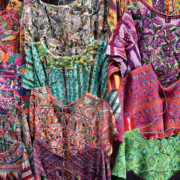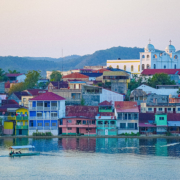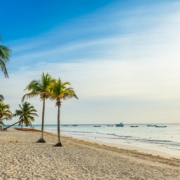Flores, Guatemala is a tropical paradise unlike any other place on Earth. With this guide, plan the trip of a lifetime.
Flores, Petén, Guatemala: An Island of Deep Time, Heat, & Resilience
Flores is a city encompassing a tropical island on Lake Petén Itzá, as well as two mainland neighborhoods and a suburb-like neighborhood resting on the San Miguel peninsula on the same lake. Lake Petén Itzá is a landlocked, freshwater lake in Flores’ Petén province.
Explore the deceptively peaceful city, and you’ll discover an ancient history of human civilization, human tenacity, and a cultural force still shaping the Americas today.
Where Is Flores, Guatemala Located?
Flores is located on an island, a peninsula, and two coastal outposts on Lake Petén Itzá, in the state of Petén in Guatemala.
Relative Locations of Flores Neighborhoods
The Island of Flores is connected to its mainland neighborhoods, Santa Elena and San Benito, by a single thoroughfare bridge. The bridge is unnamed, called only “el puente” (meaning “the causeway” in English).
While the central city on the Island of Flores is not directly connected to the San Miguel peninsula neighborhood by land, it is easy to reach by boat. Typically, a boat between the Island of Flores and the San Miguel peninsula takes 30 minutes or less.
Climate Zone Location of Flores, Petén, Guatemala
Like most of Guatemala, Flores is located in a tropical climate zone with a long rainy season. The wet season lasts from May to January, and monsoons are commonplace. February is its driest month, and the dry season only lingers two months beyond that.
What Makes Flores Culturally Significant?
The inland island city of Flores is almost the oldest continuously inhabited human settlement on the American continents (second only to Choula).
According to archeological records, people of the Maya Civilization were the first to establish a presence on the island, back in 900 B.C. At some point between 250 – 400 A.D., the Mayas expanded their settlement, building the city of Nojpetén on the island.
This overlapped with the settlement and expansion of the Itza ethnic group within Maya Civilization. At some point between 1000 – 350 B.C., the Itza built Tayasal, an expansion of Nojpetén that crossed Lake Petén Itzá to a nearby peninsula.
As a result, two vital hubs of the Maya Civilization were constructed and maintained in Flores for thousands of years. The city of Nojpetén, including the expansion of Tayasal, was the capital of the Itza Maya Kingdom for over 2000 years, until Itza rulers were overthrown by the Xiu Maya in 1446 A.D.
Resisting Spanish Conquerors
The Maya Kingdom’s Island of Flores resisted Spanish intrusion and invasion for over a century. In 1541, the Maya drove out Hernán Cortés’ first attack on the island.
Flores remained a Maya city until 1697, when it ultimately fell to Spain.
Flores’s Impact on Contemporary Guatemalan Culture
Much of Flores is protected under the Maya Biosphere Reserve, a UNESCO designation establishing protection and conservation of both archeological sites and Flores’ delicate tropical rainforest ecosystem.
Even before UNESCO’s designation, descendants of Itzal and Xiu Maya peoples have worked to preserve and restore Maya culture and traditions, grounding them in the great centers of ancient Maya Civilization.
As a result, contemporary culture is infused with Maya traditions and cultural practices of multiple ethnic groups, the history of resistance to (and coordination with) Spanish Colonialism, and modern international influences.
This holds true well beyond the Island itself. Due to Flores’ unique multicultural, historical position, it’s been uniquely able to shape contemporary Guatemalan Culture and the national identity of Guatemalans themselves.
The influences reveal themselves in every aspect of contemporary Guatemalan life: art, music, dance, religion, folklore, craft, and cuisine!
Destinations, Activities, and Attractions in Flores, Guatemala
There’s so much wonder, history, and life to experience in Flores! What might you add to your itinerary?
Nature & Wildlife
Travelers who love the beauty and wildness of nature will find there’s plenty to be had in Flores.
ARCAS (Asociaciòn de Rescate y Conservaciòn de Vida Silvestre)
ARCAS is a world-renowned non-profit organization dedicated to natural habitat protection, rescuing animals from the black market, and wildlife rehabilitation.
At ARCAS Guatemala, visitors can enjoy wildlife tours on the preserve, educational experiences with animals being rehabilitated, mangrove tours, and baby sea turtle release events.
Lake Peten Itza
Lake Peten Itza is a popular lake beside the Tayasal Ruins. Travelers visiting the lake are free to swim, boat, kayak, or explore the ruins independently.
Archeological Sites of Maya Civilization
Ak’tun Kan, La Cueva de la Serpiente
The Cave of the Serpent is a cave system beneath Flores. Visitors can explore the cavern on 45-minute and 2-hour guided tours. Cave formations, fossilized creatures, and preserved ancient pottery can be experienced up close.
Tikal National Park
Tikal National Park is the highlight of Flores for many visitors. Tikal is a UNESCO World Heritage Site, preserving and highlighting the extraordinary Tikal Ruins.
Museums & Cultural Centers
If you want a closer look at preserved and restored artifacts from ancient Maya civilization, you’ll enjoy one of Flores’ popular archeological museums.
The highest-ranked museums in Flores, Guatemala are:
- Museo Regional del Mundo Maya
- Museo del Islote Santa Barbara
- Museo de Jade
If you spend a weekend in Flores, you might have time to catch them all!
Festivals & Celebrations
The people of Flores, Guatemala hold several festivals throughout the year to celebrate and preserve different elements of their unique culture. If you visit, see if you’ll be there in time to join in some of the most popular festivities, including:
- Fiesta Patronal (Assumption) on August 15th
- Day of the Dead on November 2nd
- Dance of the Giants
- Note: this isn’t a festival itself. Rather, it’s a masked theatrical dance performed in different festivals, including Fiesta Patronal.
- The Flower Festival and Pageant in November
Best Hotels and Accommodation Options In Flores
There are plenty of affordable, well-reputed places to stay in Flores, Guatemala. You might consider:
- Las Lagunas Boutique Hotel, a tranquil, serene lodging overlooking the mangrove lagoons
- Hotel Isla de Flores, a centrally located stay with friendly staff and a rooftop pool
- Hotel Posada Tayazal, a sweet budget hotel with majestic views
Where to Eat In Flores: Local Cuisine and Must-Try Restaurants
Bistro Puertas del Cielo (formerly Las Puertas)
Bistro Puertas del Cielo, or “Bistro Gates of Heaven” is a raved-about culinary spot in the heart of Flores. The bistro focuses on authentic Guatemalan and fusion dining, regional coffee, and excellent wine. Service and price both earn high marks.
La Danta
Named after the La Danta Pyramid, La Danta Restaurante offers new takes on Guatemalan classics. Affordable, tasty meals are served either indoors, or out on the restaurant’s garden patio.
La Galería del Zot’z
La Galería del Zot’z impresses diners with its gallery’s collection of authentic Mayan art, its lively atmosphere, and its food. Don’t miss the iconic savory tamales.
Experience Flores, Guatemala With Expert Guides
Traveling is fun, but travel planning can be stressful. That’s why at Caravan, we do the work for our guests well ahead of time, so you’re free to relax and enjoy the trip.
If you’re interested in an all-inclusive trip to Flores (and a few other destinations), why not check out our weeklong Belize and Tikal Tour?
If you’d like to join in, or just want more information, we invite you to call us toll-free at 1-800-CARAVAN or 1-800-312-321-9800.




